If you were standing in the meat section of your local grocery store and these two kinds of steak were exactly the same price which one would you choose? The choice between Filet Mignon Vs New York Strip is not just about price. Consider all the various factors laid out in the article below to make your decision.

As you consider your options, remember that how carefully you cook your steak makes all the difference. Both of these cuts of beef can taste amazingly delicious if cooked properly.
🥩 What is Filet Mignon

A Filet Mignon comes from the short loin area of the animal. It’s actually the “end” of the tenderloin.

Usually two inches thick and boneless, when properly cooked the filet is a melt-in-your-mouth experience. Because this muscle is very rarely used, it is incredibly tender. The texture is amazing and consistent throughout each filet.
Filet means “strip”. Mignon is French for “dainty.” It is a very expensive cut of meat because you will only find a very small amount of Filet Mignon on each cow. This makes it a special treat and a delicacy.
The biggest drawback to a Filet Mignon is the lack of flavor. Because there is very little fat or connective tissue to render, restaurants will often serve the meat with gravy, aus jus, or some other sauce to make up in flavor what the gorgeous texture lacks.
🥩 What is New York Strip

The New York Strip also comes from the short loin of the cow. The muscle cut into New York Strip Steaks is taken from behind the rib right in front of the rear leg; a muscle which gets very little use.

For this reason, the meat does not get tough or chewy. While it does not have as much fat or marbling as ribeye, it has more fat and marbling than Filet Mignon and is therefore easier to cook.
First served in a restaurant called Delmonico’s near NY City, the New York Strip gets its name because from the 1800s on it was very popular in New York and was strongly associated with that geographic location before the popularity of the cut spread. New York Strip is found in larger quantity than filets on each cow, so it should cost less and be more available.
The biggest drawback to New York Strip is that it can dry out quickly because it is low-fat.
⚖️ Attributes
| Filet Mignon | New York Strip | |
|---|---|---|
| Cost | $35 for 6-8 ounces at a restaurant. | $32 for 10-12 ounces at a restaurant. |
| Texture | The most tender cut of beef available with a very consistent texture. | Very tender. Slightly chewier than ribeye. |
| Marbling | None. | A reasonable amount of marbling, more than filet and less than ribeye. A strip of fat on one side |
| Flavor | Very little flavor. | Excellent flavor. |
| Thickness | 1 ½ “-3” thick | 1-1½” thick |
| Cut | Lean. Low-fat content. | Lean. From the short loin right in front of the rear leg. |
| Size | Small circular cut. Usually 6-8 ounces. | Long Thin Rectangle, usually between 8-10 ounces. |
| Cooking Method | Cast Iron Pan Sear | Grill, Pan-Sear, Reverse Sear, Sous Vide, broil, or air fry. |
| Other Names | eye fillet, filet, | Ambassador steak, Omaha steak, top loin, shell steak, strip loin steak, Kansas City strip, or hotel-style steak |
❓ How to Choose
If you don’t want to choose – get a Porterhouse steak! Since New York Strip and Filet Mignon come from opposite sides of the same bone, a Porterhouse steak is both kinds of steak in one cut and includes the bone that connects the two. When you only want to get one or the other, consider these factors.
If you want a steak with less fat than ribeye, but still want to experience that classic steak flavor New York Strip is the perfect choice. Filet Mignon is a wonderful choice if you want the most tender, delicate steak possible and are excited about serving your steak with a dipping sauce of some kind. Filet Mignon is also considered elite, special and rare making it a great choice to serve and impress company as long as you know you know how to cook it correctly.
How to Cook

Filet Mignon really must be cooked medium rare to preserve what flavor it has. Anything more than this results in a tough, chewy, and dry steak with little flavor. if you want the perfect filet, pan sear the filet in a very hot cast iron skillet. Make sure it is thoroughly seared on each side to seal in the juices and then finish it with a pat or two of butter in the pan. Your goal is an internal temperature of 130º-135ºF. Serve the meat with aus jus, horseradish sauce, gravy or your sauce of choice.
Begin with room temperature steaks for best results. Season your steaks on both sides while you wait for your grill to preheat. Grill your New York Strip at high heat for four minutes per side for a quick sear and medium rare finish. Other popular methods for cooking this steak include Sous Vide, pan sear, reverse sear, broiling or the air fryer.
📝 Recipe Tips
Preheat your grill or pan. Getting your cooking surface nice and hot will provide that instant sear which seals in the juice and flavor of your meat.
Add seasoning to both sides of the meat before you put it on the heat. The salt will begin flavoring the steak on both sides as it cooks.
Get your steaks to room temperature before they hit the heat. This results in a more tender and flavorful steak.
If you pan sear your steak, you can deglaze the plan with a little beef broth to make the aus jus. Add a roux to this flavorful liquid to make a gorgeous pan gravy.
How to Serve
Either of these steaks is lovely served with a homemade horseradish sauce or au jus. Traditional steak sides such as baked potatoes, sweet potatoes, or a salad are all excellent choices. Fresh crusty bread, bread sticks or rolls are always welcome.
How to Store Leftovers
Keep leftover steaks in the refrigerator for one or two days. Store your steaks in an airtight container or freezer-quality storage bag. Reheat your steaks in a hot skillet for best results.
Before you freeze your steak leftovers, first consider how you will use them in the future. If you think you will want to dice the steak for steak and eggs or a quick stir fry, go ahead and dice it up before freezing. If you will plan to reheat it as a whole steak that works as well. Freeze the steak or steak pieces in an airtight container. It will keep frozen for up to three months.
Cube your leftover steak and use it in a plethora of ways to take full advantage of your tasty leftovers. Make it into steak sandwiches with cheddar and arugula or cheesesteaks with provolone and roasted onions and peppers. Add it to a stir fry with chicken and shrimp or use it for fajitas and tacos. Throw the steak in a soup. Toss your steak on a salad. Mix the steak with alfredo and pasta. Make a Chipotle-style bowl by seasoning your leftover steak with fajita seasonings and serving it over rice with guacamole, cheese, sour cream, and salsa or pico de Gallo.
Recipe FAQ
Ounce per ounce, Filet Mignon costs more.
Without a doubt, Filet Mignon is the most tender cut of beef available.
These two cuts of beef come from opposite sides of the same bone. The main difference is that New York Strip has a little more fat and marbling and thus more flavor while Filet Mignon is more tender. Other differences include size, shape and thickness.
This steak is cut from the short loin of the cow directly in front of the rear leg, behind the ribs, and is boneless.
This steak is a boneless cut from the short loin of the cow from the opposite side of the bone where a New York Strip is cut from.
Related Articles

Jason’s been firing up the grill for over 30 years after graduating from the US Coast Guard Academy. His love of finely-grilled steak and chicken led him to buy his first Weber grill to put on his apartment patio in 1992. Each military move led to a new grill (a mixture of gas and charcoal) until he fell in love with the Big Green Egg in 2008. Since then, he has added another 4 grills to the collection. Yes, he has a problem. Jason loves smoking in the ceramic BGE with exotic woods including olive wood from Egypt and hard to find varieties such as sassafras and orange wood. Jason takes the term “foodie” to a whole new level, jumping at the chance to take food tours and cooking classes during foreign travels. These have provided inspiration to incorporate new ideas into recipes when he gets back home. He has been featured in Fox News, Parade, Yahoo News, Kansas City Living and more. After retiring from the military and moving to southwest Florida, he has focused grilling and smoking locally sourced meats and fish (read: he likes to catch his own fish!)









Leave a Reply